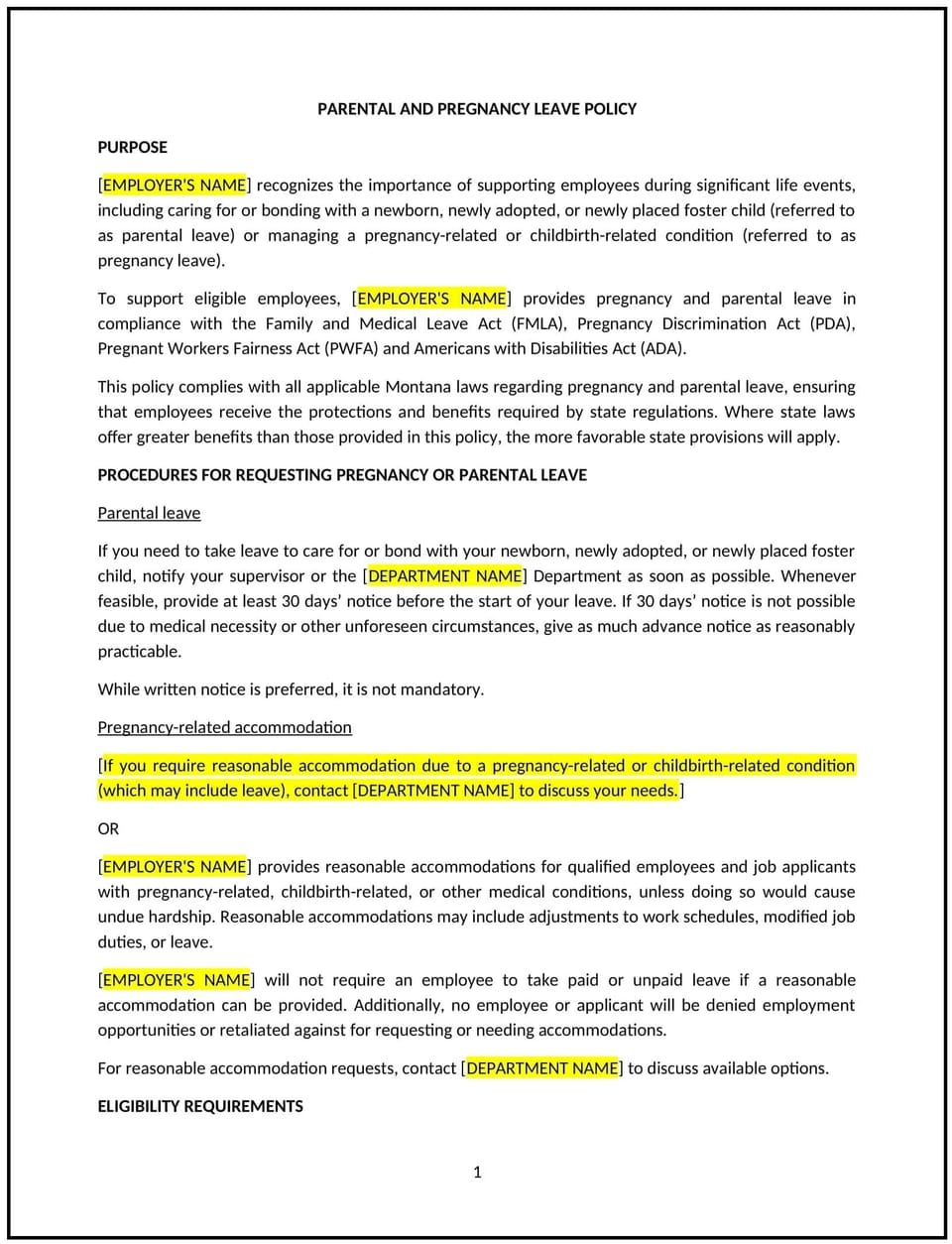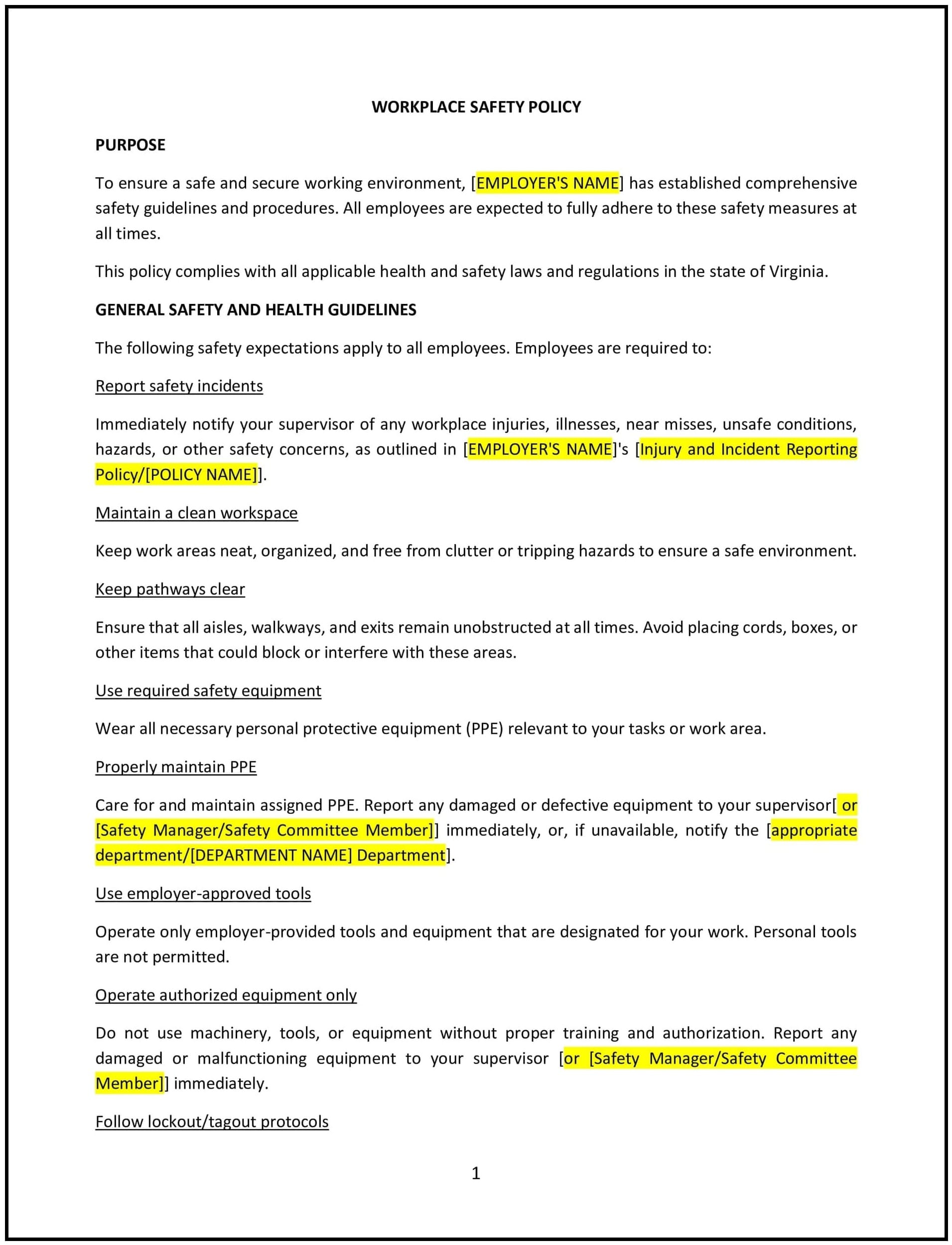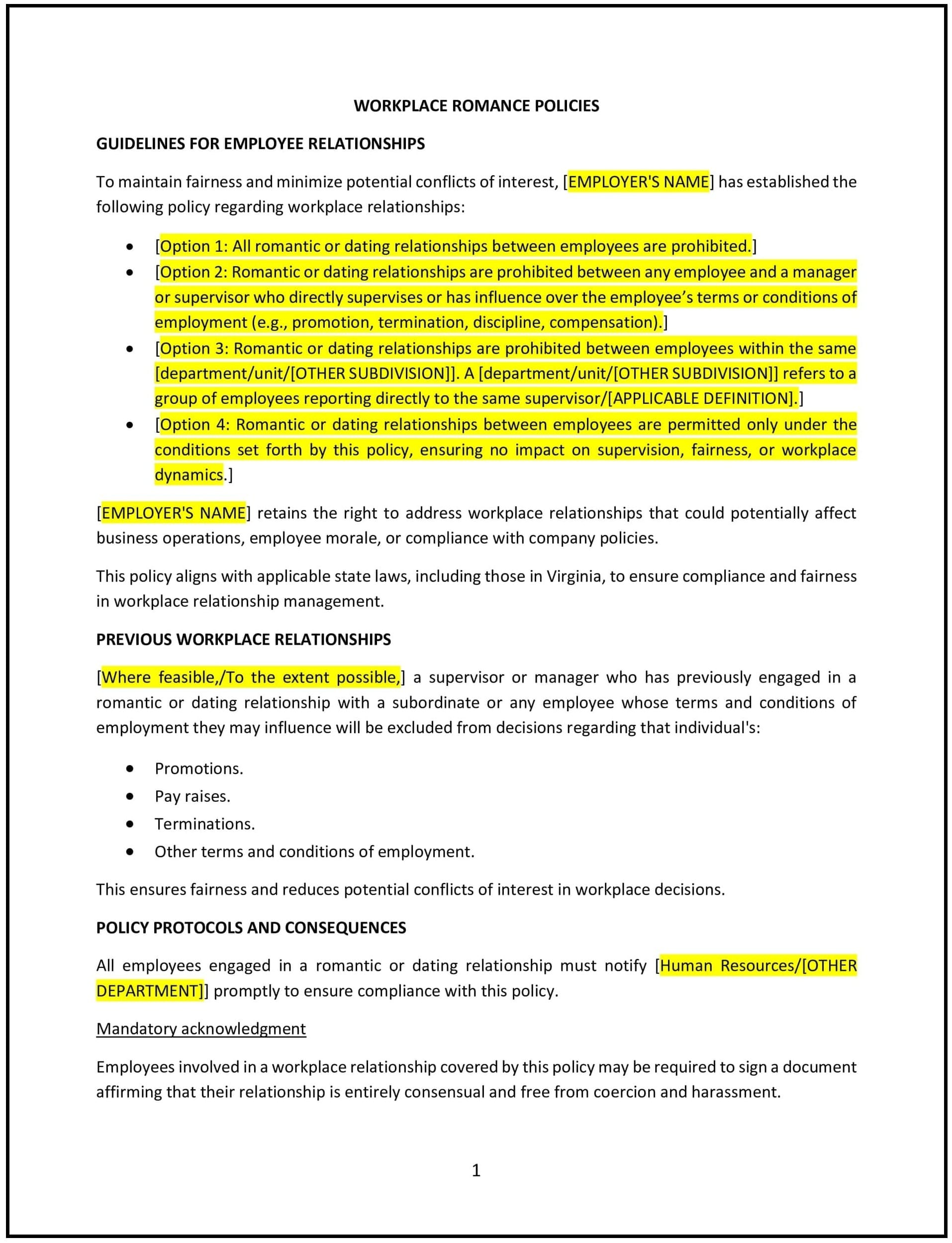Parental and pregnancy leave policy (Montana): Free template

Parental and pregnancy leave policy (Montana)
A parental and pregnancy leave policy helps Montana businesses manage employee absences related to pregnancy, childbirth, and childcare. This policy outlines the company’s approach to granting leave for pregnancy-related medical conditions, childbirth recovery, and parental bonding, ensuring a supportive work environment for all employees during such life events.
By implementing this policy, businesses can foster a family-friendly environment, support employee well-being, and maintain compliance with state and federal laws while ensuring equal opportunities for all employees.
How to use this parental and pregnancy leave policy (Montana)
- Define eligibility: The policy should specify who is eligible for parental and pregnancy leave, including full-time and part-time employees. It should also outline any requirements, such as length of employment, for eligibility.
- Set leave duration: The policy should outline the duration of pregnancy and parental leave, specifying any state-specific regulations that may apply to the length of time employees can take for these purposes.
- Define paid and unpaid leave: The policy should clarify whether the company offers paid parental leave, paid family leave, or unpaid leave. It should also explain how any paid leave is structured, such as paid time off (PTO), short-term disability, or other benefits.
- Outline the process for requesting leave: Employees should be instructed on how to request parental or pregnancy leave, including required notice periods, documentation (such as a medical certificate for pregnancy-related conditions), and any forms needed to formalize the request.
- Address job protection and benefits during leave: The policy should confirm that employees will be able to return to the same or equivalent position after their leave, and outline how benefits such as health insurance will be maintained during the leave period.
- Include guidelines for parental bonding leave: The policy should clarify whether bonding leave is available for both mothers and fathers or non-birthing parents, specifying the length of leave and any distinctions between maternity, paternity, or adoption-related leave.
- Review and update regularly: The policy should be reviewed periodically to ensure it remains aligned with any updates in state laws, federal regulations, or changes to the company’s benefits offerings.
Benefits of using this parental and pregnancy leave policy (Montana)
This policy provides several key benefits for Montana businesses:
- Supports employee well-being: Offering paid or unpaid leave for pregnancy and parental bonding helps employees maintain their health and well-being during important life transitions, improving job satisfaction and loyalty.
- Promotes work-life balance: The policy helps employees balance their family responsibilities with work, leading to a more engaged and productive workforce.
- Attracts and retains top talent: A clear and generous parental leave policy makes the company more attractive to prospective employees, especially those considering family life events. It can also improve retention by showing support for working parents.
- Enhances workplace morale: A family-friendly policy promotes inclusivity and fairness, which can improve overall morale and reduce employee turnover.
- Demonstrates legal compliance: By implementing a well-defined parental and pregnancy leave policy, businesses can ensure they meet the requirements set forth by state and federal law, reducing legal risks associated with maternity and paternity leave.
- Supports diversity and inclusion: The policy supports the business’s commitment to diversity and inclusion by ensuring that all employees, regardless of gender or parental status, have equal access to family leave benefits.
Tips for using this parental and pregnancy leave policy (Montana)
- Communicate the policy clearly: Ensure that all employees are aware of the parental and pregnancy leave policy and understand their rights and options when it comes to taking leave.
- Provide support throughout the process: Ensure that employees have the resources and support they need to navigate the process of taking leave, including assistance with paperwork, documentation, and return-to-work plans.
- Be flexible with employees’ needs: Recognize that employees may have different needs based on their situation and offer flexible solutions, such as part-time work options or staggered return dates, if possible.
- Ensure job protection: Reinforce that employees will have their jobs protected during leave, and ensure that they are able to return to the same or a similar role after the leave period ends.
- Regularly assess the policy’s effectiveness: Review the policy regularly to ensure that it meets the needs of the workforce and complies with current laws and best practices in parental leave.
- Offer additional resources: Consider providing additional support for employees during their leave, such as access to counseling, lactation support, or parenting resources, to enhance the overall experience.
Q: Why should Montana businesses implement a parental and pregnancy leave policy?
A: Businesses should implement this policy to support employees through pregnancy, childbirth, and parental bonding, promote work-life balance, attract and retain top talent, and ensure compliance with state and federal leave laws.
Q: Who is eligible for parental and pregnancy leave?
A: The policy should define eligibility based on criteria such as employment duration and full-time status. Eligibility often depends on both federal and state laws, as well as the business’s specific policies.
Q: How long can employees take pregnancy and parental leave?
A: The policy should specify the duration of leave available to employees, which may vary depending on whether the leave is for pregnancy-related medical reasons, childbirth recovery, or parental bonding.
Q: Is parental leave paid or unpaid?
A: The policy should clarify whether parental leave is paid or unpaid. Many businesses provide a combination of paid time off, short-term disability, or unpaid leave, depending on the employee's circumstances and tenure.
Q: How should employees request pregnancy or parental leave?
A: Employees should notify their manager or HR department in advance of their expected leave dates, providing any required documentation (e.g., medical certificates or proof of childbirth) and following the formal request process outlined in the policy.
Q: Can employees take bonding leave as non-birthing parents?
A: Yes, the policy should specify that bonding leave is available to both mothers and fathers or non-birthing parents, ensuring equality in the leave process.
Q: Are employees entitled to return to their position after pregnancy or parental leave?
A: Yes, employees are generally entitled to return to the same or equivalent position following their leave. The policy should reinforce job protection and clarify the process for returning to work after leave.
Q: How are benefits handled during parental or pregnancy leave?
A: The policy should specify whether employee benefits, such as health insurance, will continue during the leave period and any steps employees need to take to ensure coverage during their time off.
Q: How often should the parental and pregnancy leave policy be reviewed?
A: The policy should be reviewed periodically, at least annually, to ensure it aligns with current legal requirements, employee needs, and the company’s objectives regarding family leave.
Q: What happens if an employee’s leave extends beyond the original plan?
A: The policy should outline the steps employees should take if they need to extend their leave, including providing notice to the employer and following any procedures for extending the duration of the leave.
This article contains general legal information and does not contain legal advice. Cobrief is not a law firm or a substitute for an attorney or law firm. The law is complex and changes often. For legal advice, please ask a lawyer.


